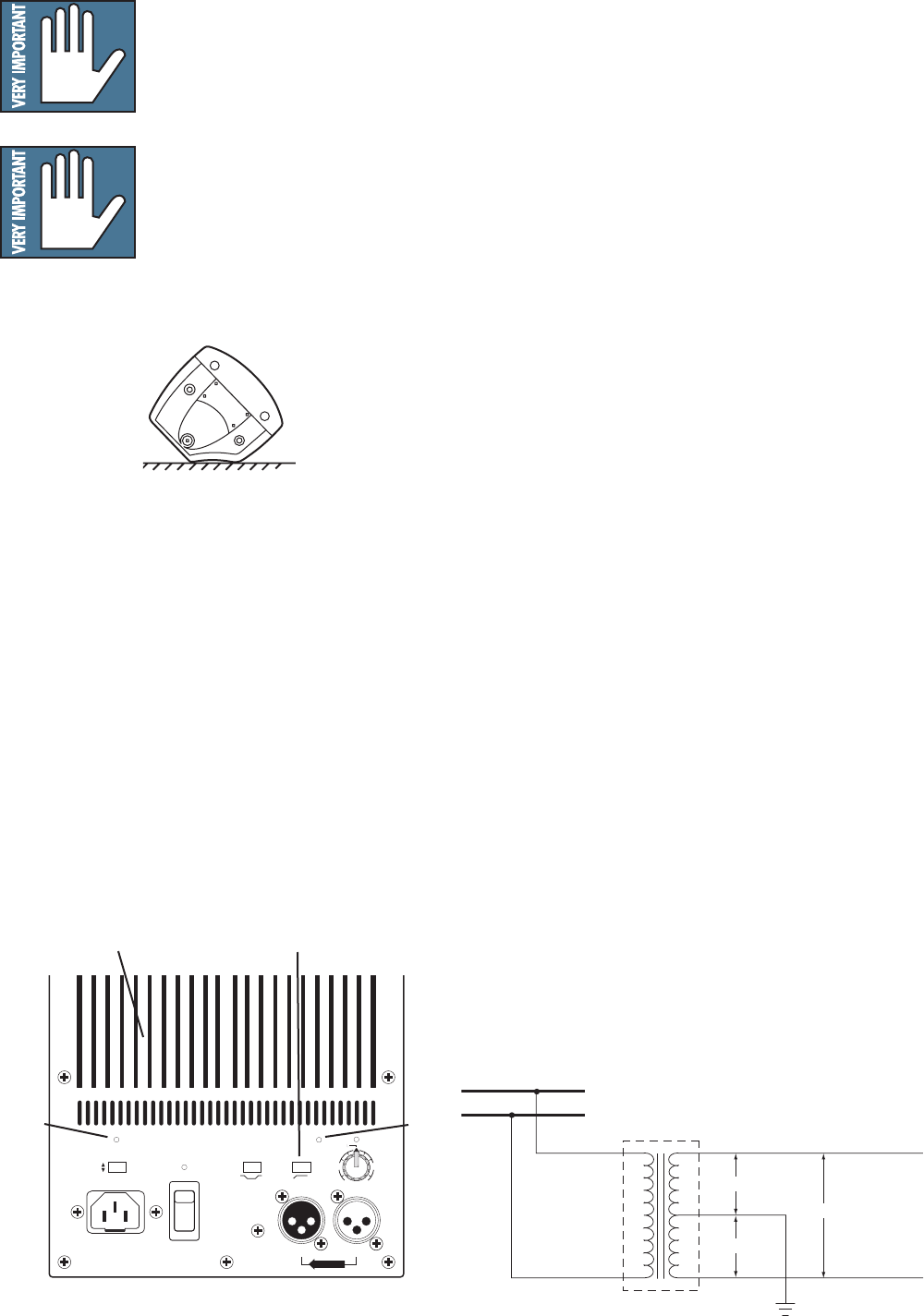
12
AC POWER CONSIDERATIONSTHERMAL CONSIDERATIONS
HEATSINK
THERMAL PEAK
LOW CUT
The amplifiers inside the SRM450v2s
are
convection cooled by a large heatsink.
For efficient cooling, it is important to
allow at least six inches of free space
behind the SRM450v2.
If you use the SRM450v2 on its side for
stage monitor applications, we highly
recommended that you engage the rear
panel LOW CUT switch. This will allow
more power for useful monitor
frequencies, while reducing the
possibility of overheating.
If the ambient temperature in the room is high, though
highly unlikely, it could cause the amplifiers to overheat.
In this case, you should try aiming a fan at the heatsink to
increase the air flow through the fins.
During a performance, don’t have it cranked so high that
the rear panel PEAK LED is blinking frequently or lighting
continuously. You should turn down the LEVEL control a
notch or two to avoid overheating the amplifiers or your
neighbors.
If the amplifiers do overheat, a built-in thermal
switch will activate, placing the amplifiers into standby.
When the amplifiers have cooled down to a safe
operating temperature, the thermal switch will reset
and the SRM450v2 will resume normal operation.
Be sure the SRM450v2 is plugged into an outlet that is
able to supply the correct voltage specified for your model.
If the voltage should drop below 97% of the specified line
voltage, the built-in amplifiers will no longer be able to
supply rated power. (They will continue to operate down
to 75% of the rated line voltage, but won’t reach full power,
resulting in lower headroom).
Under maximum SPL conditions, where musical peaks
are clipping, the SRM450v2 120V model draws 2.5 amps on
average (1.3 amps for the 240V model). Under normal
conditions, the current draw is below 1 amp.
We recommend that a stiff (robust) supply of AC power
be used because the amplifiers place high current demands
on the AC line. The more power that is available on the line,
the louder the speakers will play and the more peak output
power will be available for cleaner, punchier bass. A
suspected problem of “poor bass performance” is often
caused by a weak AC supply to the amplifiers.
AC Power Distribution
A 240 VAC center-tapped service entrance transformer
serves the majority of AC outlets encountered in homes
and clubs (in the U.S.). This provides two phases of AC
power on either side of the center tap, at 120V each.
If lighting is used in a show, it is preferable to power
the lights from one leg of the service, and power the audio
equipment from the other leg. This will help minimize
noise from the lights coupling into the audio (particularly
if SCRs, or light-dimmer switches, are used).
Wherever possible, connect all of your equipment to the
same electrical circuit. This will help reduce the possibility
of a ground loop problem causing an annoying hum in your
speakers.
Low power components such as tape decks, mixers,
effects processors and CD players should be connected to
the same outlet as the SRM450v2s. Use fused power strips
as shown in the diagram on the next page. Make sure that
the total current draw of your components does not exceed
the capability of the outlets and power strips.
POWER
SIGNAL PRESENT
INPUTTHRU
THERMAL PEAK
TIMED TURNOFF
ON
OFF
CONTOUR LOW CUTON
75 Hz12k/A IR10 0Hz
+3dB
MI C
LIN E
LEVEL
(+ 4dBu )
NO RM A L
+40dB
OO
ACTIVE SOUND REINFORCEMENT SYSTEM
PARALLEL
TRANSFORMER
120V
120V
240V
HIGH VOL TAGE POWER LINE
EARTH
GROUND
(NEUTRAL)
PRIMARY
WINDING
SECONDARY
WINDING
240V CENTER-TAPPED SECONDARY


















